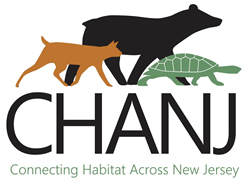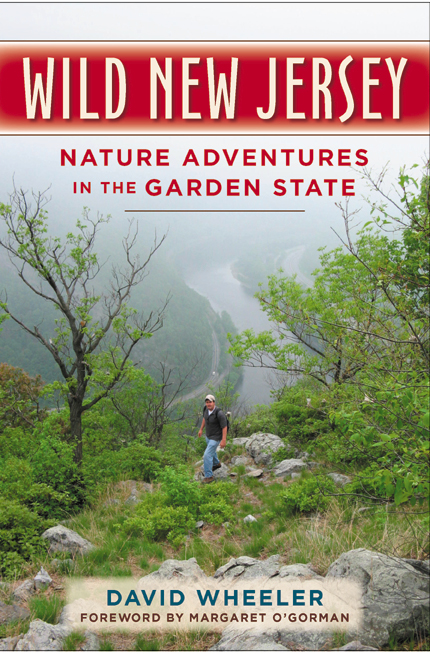Wild New Jersey Revisited: Salamander Crossing – It Could Be Tonight!
by David Wheeler

Wild New Jersey Revisited is a monthly series of excerpts from Conserve Wildlife Foundation executive director David Wheeler’s 2011 book Wild New Jersey: Nature Adventures in the Garden State. Today we focus on a springtime migration…of miniature proportions – and one that could be occurring again tonight!
Excerpt from Chapter 22
Wild Nights in Suburbia
It’s not often that I find myself praying for rain on the way out the door. No, when I’m about to spend three-plus hours standing outside on a chilly Sunday evening in March, I usually prefer to stay dry. I’m kind of picky that way.
So if it seems odd that I let out a quick cheer when a few raindrops appear on my windshield as I navigate treacherous backroads in Warren County – well, there’s good reason. Without the rain, there are no salamanders crossing the road. And without salamanders or frogs, the scientists and a truckload of committed volunteers have no reason to be out here in the chilly twilight.
I arrive at the site, and my windshield is dry again. I fear that those lone raindrops were just a big tease. It could be a long night. Somewhere in the distance, a great horned owl hoots. Near the road, a lone spring peeper calls without end like a soapbox preacher. Perhaps he is divining the future for his fellow amphibians, and for us.
After all, this is their migration. We are just here as bouncers, keeping cars and trucks from crashing their party. Tonight, rain is the only question mark. The temperature is in the ideal range, mid- to upper forties. As planned, the night grew dark when the sun went down. (Whew – that’s a relief!) So that’s two out of three needs for the crossing to begin.
All we need is rain. One volunteer checks the Doppler radar weather forecast on his phone every few minutes.
“There’s a system over Lehigh Valley now, but it’s moving our way pretty quickly.”
Another volunteer reminisces about the good old days.
“2002 – that was the best year. We got a torrential downpour.”

Salamander Crossing
The volunteers take their places. For the next few hours, each person will walk a roughly 50-foot stretch along the dotted yellow traffic line in the middle of the road. Volunteers will tally any amphibians that pass through by number and species. The salamanders and frogs cross the road to get from their upland wintering areas to the vernal ponds on the other side, where they can safely lay their eggs. These vernal ponds, or temporary pools, dry up for part of the year. That means no fish are present to eat the amphibian eggs and tadpoles.
“We focus not only on salamanders, but on amphibians as a whole, because they are ecological indicators,” says Kris Schantz of New Jersey Fish and Wildlife, who started the migration night surveys in 2002 and has run them every year since. “They play an important role in helping us understand the ecosystem health, water availability, and water quality. If there are problems with the water, we will see it in them first.”
Schantz, along with MacKenzie Hall from the Conserve Wildlife Foundation of New Jersey and Mike Anderson from New Jersey Audubon, works with municipalities to coordinate these rural road closings for two or three nights each year. Yet Schantz is also calling for a permanent solution: culverts underground. Such systems are in place in Massachusetts and Europe, but have not yet been tried in New Jersey, which has more roads per square mile than anywhere else in the country. Culverts would do wonders here.
The first three-hour shift is ending without a single crossing. I say my goodbyes and begin walking back to the car. And then – “Spring peeper!”
“Salamander!”
A volunteer shines his beam on the spotted salamander, a good six inches of stunning dark blue dotted with bright yellow spots. A few feet away, the spring peeper – a tiny tree frog no bigger than my thumb, with a beautiful darkened X pattern across its olive-colored back – slowly makes its way across the road. It feels great to see these brave individuals, who appear to be testing the conditions for the rest of their groups – perhaps they are the amphibian equivalents of “guinea pigs.”
Oasis in the Forest
While state surveys are manned only by trained volunteers, there’s another opportunity for anyone to experience a salamander migration first-hand. Each March and April in East Brunswick, the town closes down a half mile of Beekman Road to drivers for a handful of rainy nights. Scores of local residents gather to observe the migration, watching spotted salamanders, spring peepers, red efts, and red-backed salamanders.
This unique public event started in the early 2000s when environmental scientist David Moskowitz found his first dead salamander on the road. He told then-Mayor William Neary about it, and the mayor was surprisingly receptive to closing the road. Each year since, the rural road has shut down for up to nine nights, depending on the quality of each mass movement.
The crossing attracts large numbers of participants, largely because it seems like such a different world in the middle of suburban East Brunswick. During my visit to the crossing, the frog calls echo so loudly that I might as well have entered a tropical rainforest.
“On many nights, we actually have a parking problem, so many families want to come out,” says Moskowitz. “Our message is that the perfect analogy of the vernal pool is the oasis in the forest. If you lose a vernal pool, you lose all of those species that go into a vernal pool.”
Ten Years Gone

In the decade since Wild New Jersey was published, the amphibian crossings in northwestern New Jersey have continued each year, though with some scaling back in 2020-21 due to Covid safety restrictions. Christine Healy of Conserve Wildlife Foundation manages the 2021 crossing project, and MacKenzie Hall still provides major oversight – albeit now as a New Jersey Division of Fish and Wildlife scientist.
The Division has since launched CHANJ (Connecting Habitats Across New Jersey) to address the habitat connectivity concerns mentioned above in biologist Kris Schantz’s remarks, including constructing underground wildlife culverts in places like River Road in Bedminster and an ongoing project at Waterloo Road in Sussex County. The PBS program EcoSense for Living spotlighted New Jersey’s leadership on wildlife crossings in an episode last year.
David Moskowitz continues to manage the East Brunswick amphibian crossing, attracting hundreds of people each spring to safely enjoy the wonders of seeing these unique creatures, including introducing many people to the first close-up looks at a salamander or spring peeper. Visit the environmental commission’s project webpage for a detailed overview and regularly posted updates of conditions and likelihood of the road closing during this time of year.
– David Wheeler, March 2021
*Special Note, March 18, 2021*
Tonight’s forecast calls for relatively ideal conditions, so be sure to check out the East Brunswick salamander crossing updates for the likelihood of a road closure and the chance to visit the amphibian migration tonight!
Stay tuned for April’s installment of “Wild New Jersey Revisited” – a trip to the “Bayshore Bayou” in search of bald eagles!
Read the previous installments of Wild New Jersey Revisited:
Part One: A Predator Returns to the State’s Rugged Northwest
Part Two: A Taste of the Arctic at Sandy Hook
Purchase a copy of Wild New Jersey from the CWF Store.




